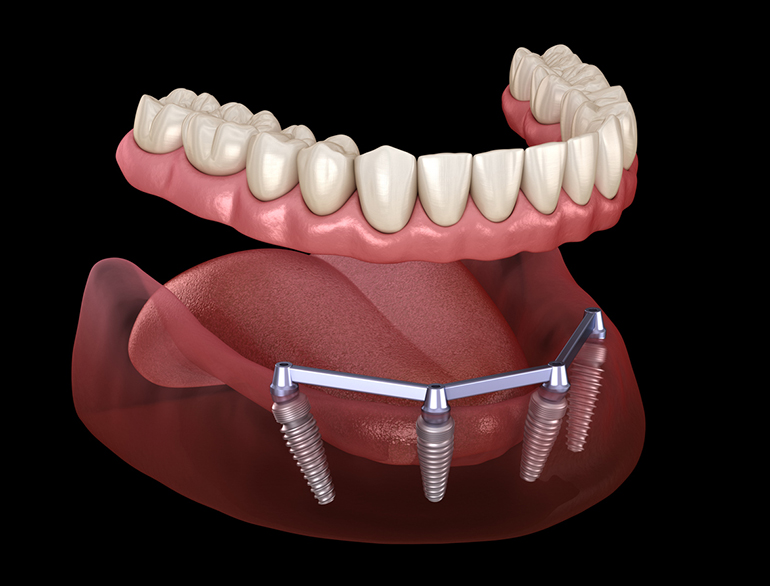What is a Bridge in Dental Work? Your Comprehensive Guide

A dental bridge is a dental work that replaces missing teeth by using crowns to attach artificial teeth, restoring chewing function and improving oral health. It consists of crowns on natural teeth surrounding the gap and artificial teeth in between.
Dental bridges are a permanent appliance that can enhance your appearance and restore tooth functionality.
Types Of Dental Bridges
A traditional dental bridge consists of a false tooth or teeth being held in place by dental crowns that have been cemented onto each of the abutment teeth. This type of bridge is commonly used and provides a reliable solution for tooth replacement. It is suitable when there are healthy natural teeth on both sides of the gap.
Maryland dental bridges use metal, porcelain, and/or ceramic wings to bind a replacement tooth to the backs of adjoining, natural teeth. This type of bridge is a conservative option as it does not require the abutment teeth to be extensively prepared.
Cantilever dental bridges are used when there is only one healthy natural tooth adjacent to the gap. The false tooth is supported by a dental crown that is cemented onto the healthy tooth.
An implant-supported dental bridge is a more advanced option that utilizes dental implants to anchor the bridge. Dental implants are surgically placed in the jawbone and provide a strong foundation for the bridge. This type of bridge is ideal for those who have multiple missing teeth or insufficient natural teeth to support a traditional bridge.
Dental bridges are an effective solution for replacing missing teeth. They restore chewing function, improve oral health, and enhance your appearance. Whether you need a traditional bridge, a Maryland bridge, a cantilever bridge, or an implant-supported bridge, consulting with a dental professional will help determine the best option for your specific needs.
Who Needs A Dental Bridge?
Dental bridges replace missing teeth. They can restore chewing function, enhance your appearance and improve your oral health. A dental bridge consists of crowns (that fit over your natural teeth on either side of the space) and artificial teeth (that “bridge the gap” in your smile).
Individuals with missing teeth can benefit from dental bridges. They are suitable for those who want to restore chewing function and enhance appearance.
Different types of dental bridges include Maryland dental bridges, traditional dental bridges, and dental bridges made from resin or porcelain. Dental bridges are a permanent appliance that replaces missing teeth and are fixed to your natural teeth.
Some potential problems or disadvantages of dental bridges may include dislodging, sweet sensitivity, breakage, gum disease and bone loss, and chewing or biting sensitivity. It is important to note that bridges are not as strong as dental implants.
Benefits Of Dental Bridges
| What is a Bridge in Dental Work |
Dental bridges replace missing teeth. They can restore chewing function, enhance your appearance, and improve your oral health. A dental bridge consists of crowns (that fit over your natural teeth on either side of the space) and artificial teeth (that “bridge the gap” in your smile).
A dental bridge is used to bridge the gap between two healthy teeth where one or more teeth are missing. It is a permanent appliance that replaces a missing tooth or missing teeth. There are different types of dental bridges, such as Maryland dental bridge that uses metal, porcelain, and/or ceramic wings to bind a replacement tooth to the backs of adjoining natural teeth.
When it comes to the lifespan of a dental bridge, it can last for a long time with proper care. However, there can be some potential problems or disadvantages associated with dental bridges, such as dislodging, sweet sensitivity, breakage, gum disease, and bone loss. Additionally, there might be some discomfort or soreness initially when a temporary bridge is first put in.
While dental bridges are a popular option, it is worth noting that dental implants are generally considered stronger and provide a stronger bite compared to bridges.
How To Care For Dental Bridges
What is a Bridge in Dental Work: Dental bridges are used to replace missing teeth and provide benefits such as restored chewing function, enhanced appearance, and improved oral health. A bridge consists of crowns that fit over your natural teeth on both sides of the gap, along with artificial teeth that bridge the space in your smile. There are different types of dental bridges available, including Maryland dental bridges and traditional bridges. A dental bridge is a permanent appliance that is fixed to your natural teeth and cannot be removed. It can last for a long time with proper care and regular dental check-ups. When caring for dental bridges, it is important to practice regular brushing and flossing, avoid hard and sticky foods, and visit your dentist for regular check-ups. So, if you have missing teeth, a dental bridge can be a great solution to restore your smile and oral function.
How Long Does A Dental Bridge Last?
What is a Bridge in Dental Work? Dental bridges replace missing teeth. They can restore chewing function, enhance your appearance, and improve your oral health. A dental bridge consists of crowns (that fit over your natural teeth on either side of the space) and artificial teeth (that “bridge the gap” in your smile).
How long does a dental bridge last? The average lifespan of a dental bridge can vary depending on several factors affecting its lifespan. These factors include oral hygiene practices, diet, dental habits, material used for the bridge, and the overall health of the surrounding teeth and gums. On average, a well-maintained dental bridge can last for approximately 10 to 15 years. However, with proper care and regular dental check-ups, it can even last longer.
Some of the disadvantages of a dental bridge include the potential problems of dislodging, sweet sensitivity, breakage, gum disease, and bone loss, and chewing or biting sensitivity. In comparison to dental implants, bridges are not as strong. It is important to discuss with your dentist which option is best for your specific dental needs and preferences.
How Painful Is A Dental Bridge?
A dental bridge is a permanent solution for replacing missing teeth by bridging the gap with artificial teeth. While the placement of a temporary bridge may cause some initial discomfort, it should subside within a few days. Improper fitting of traditional bridges can lead to teeth shifting and painful rubbing.
However, bridges are not as durable as dental implants and may compromise the strength of your bite.
|
What is a Bridge in Dental Work Dental bridges replace missing teeth. They can restore chewing function, enhance your appearance, and improve your oral health. A dental bridge consists of crowns (that fit over your natural teeth on either side of the space) and artificial teeth (that “bridge the gap” in your smile). How Painful is a Dental Bridge? The most common discomfort with a dental bridge is when a temporary bridge is first put in, and your mouth is adjusting to it. This might cause some soreness and discomfort, but it should go away within a few days. Additionally, if a traditional bridge is not fitted properly, it can cause the teeth to shift and rub against each other, resulting in significant pain. |
Disadvantages Of Dental Bridges
Potential problems with dental bridges:
|
Dental bridges may have some potential problems or disadvantages that you should be aware of. One common issue is the dislodging of the bridge. While it can be stressful to have a restoration fall out of your mouth, it is generally easy to fix. Another problem that some individuals experience is sweet sensitivity, which means that consuming sugary foods or drinks may cause discomfort. Breakage of the bridge is also a possibility, although it is not very common.
Gum disease and bone loss can be potential issues with dental bridges. It is important to maintain good oral hygiene and visit your dentist regularly to prevent these complications. Additionally, some individuals may experience chewing or biting sensitivity with dental bridges. Overall, while dental bridges can be a great solution for replacing missing teeth and improving oral health, it is important to consider these potential problems and discuss them with your dentist.

Credit: blyssdental.com
Frequently Asked Questions Of What Is A Bridge In Dental Work
How Long Does A Dental Bridge Last?
A dental bridge can last for several years. However, its lifespan depends on factors such as oral hygiene and regular dental check-ups. It is essential to take care of a dental bridge to ensure its longevity.
How Painful Is A Dental Bridge?
A dental bridge can be painful when first put in, causing soreness and discomfort that typically goes away within a few days. Improper fitting of traditional bridges can lead to teeth shifting and painful rubbing. Disadvantages of bridges include potential dislodging, sweet sensitivity, breakage, gum disease, and bone loss.
Implants are often stronger and do not require work on surrounding teeth. Bridges are not permanent solutions.
What Are The Disadvantages Of A Dental Bridge?
Potential problems or disadvantages of dental bridges include the risk of dislodging, sensitivity to sweets, breakage, gum disease and bone loss, and chewing or biting sensitivity. Bridges are not as strong as dental implants and require work on surrounding teeth.
They also do not replace the root of the missing tooth, which may lead to continued bone loss.
Is A Bridge Better Than An Implant?
A bridge is not as strong as an implant and can weaken your bite. Bridges require work on surrounding teeth, while implants do not. Also, bridges do not replace the missing tooth root, potentially causing bone loss.
Conclusion
A dental bridge is a reliable and permanent solution for replacing missing teeth. It consists of crowns that fit over your natural teeth and artificial teeth that bridge the gap in your smile. This dental appliance can restore your chewing function, improve your appearance, and enhance your oral health.
Unlike implants, bridges require work on surrounding teeth and may not be as strong, but they are a cost-effective option. However, there can be some disadvantages such as the potential for dislodging or sweet sensitivity. Overall, a dental bridge offers an effective solution for tooth replacement.





